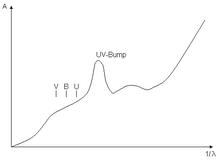Extinction (astronomy)
In astronomy, extinction is the attenuation of light from celestial bodies when it passes through the earth's atmosphere or interstellar matter .
The term extinction is used to summarize the attenuation due to absorption in the medium traversed and due to scattering , cf. Absorbance (optics) . This weakening depends on the wavelength and is associated with a discoloration. It also depends on the volume of the irradiated atmosphere and on its specific contents of water vapor , carbon dioxide , ozone , clouds and aerosol .
Absorbance in the earth's atmosphere
The extinction in the earth's atmosphere depends on the location, the wavelength and the zenith distance . If a star or another celestial body is close to the horizon , the path through the atmosphere is longer and the light weakening is greater. The atmospheric extinction increases with the zenith distance. At its zenith , it makes up about 0.28 mag (23%) at sea level and is essentially caused half by Rayleigh scattering on air molecules and half by scattering on aerosol particles . Since blue light is scattered more strongly in the atmosphere than red light, stars near the horizon appear reddish and the sky bluish.
Interstellar extinction
The extinction in the interstellar medium is mainly caused by interstellar dust . For different lines of sight in our Milky Way the extinction values are very different due to the irregular structure of the interstellar medium.
The extinction parameter is defined by the distance module :
Denote:
- the apparent brightness at the wavelength
- the absolute brightness at the wavelength
- the distance of the source in parsec .
The absorbance as a function of the wavelength is shown as an absorbance curve (see figure). In the optical range (see UBV system ) the extinction varies only slightly, but is not constant: the blue portion is absorbed / scattered more strongly than the red. This means that initially white light is not only weakened by the interstellar extinction , but also colored reddish . In the range of infrared and radio waves (left part of the diagram) the interstellar extinction is very small, i. that is, in these spectral ranges (e.g. the galactic center ) one can observe almost undisturbed. In the high-energy spectrum, on the other hand, the extinction increases very strongly.
A precise explanation of the course of the extinction curve is not yet possible, as there is no consistent model for the composition of the interstellar dust. The UV bump at 220 nm is probably caused by graphite particles.
See also
Web links
- Standard values for the atmospheric absorbance ( Memento from June 17, 2006 in the Internet Archive )
- engl. Explanation with curves for the atmospheric absorbance







